How to Build a Food Delivery App for Both iOS and Android?

In today's fast-paced world, food delivery apps have become a staple in people's lives, allowing them to order food with just a few taps on their smartphones. With the growing demand for food delivery services, the food delivery app industry is thriving. If you're an entrepreneur or a business looking to enter this lucrative market, you must understand the steps involved in developing a food delivery app for both iOS and Android platforms. This comprehensive guide will walk you through the key elements of Food Delivery App Development and how to successfully build an app that works seamlessly across devices.
Key Considerations Before Building a Food Delivery App
Before diving into the development process, it is essential to understand the different aspects that will shape the final product. A well-thought-out food delivery app should cater to all the user needs, streamline the order process, and enhance the overall experience. Consider the following factors:
- Target Audience: Identify the demographics you wish to target, such as urban dwellers, students, professionals, etc. Understanding your target audience will help you tailor the app's features and design.
- Competitor Research: Analyze existing apps in the market to see what works well and what doesn’t. Apps like UberEats, DoorDash, and Grubhub have set a high bar in the food delivery industry.
- Monetization Model: Decide on your revenue model. Most food delivery apps make money through delivery fees, commissions from restaurants, subscription plans, or in-app advertising.
Features of a Food Delivery App
A successful Food Delivery App Development process must focus on essential features that make the ordering experience smooth and hassle-free. Below are some must-have features for both customers and restaurant partners.
Customer Features
- User Profile: Allows customers to create personalized profiles to save delivery preferences, payment methods, and order history.
- Search & Filters: Customers can search for restaurants by cuisine, location, or food type. Filters should help narrow down search results based on ratings, price, and delivery time.
- Order Tracking: Real-time order tracking enables users to track their orders, from the kitchen to the doorstep.
- Payment Integration: Integration with multiple payment gateways like PayPal, credit/debit cards, and mobile wallets ensures seamless payments.
- Ratings & Reviews: Users can rate the food, delivery service, and the overall experience, helping future customers make informed decisions.
- Push Notifications: Notify customers about order updates, new restaurant offerings, or special discounts.
Restaurant Features
- Restaurant Profile: Allows restaurants to create and manage their profiles with information like location, menu, and hours of operation.
- Order Management: The ability to accept, modify, or reject incoming orders, and track delivery status.
- Menu Management: Restaurants can update their menu, prices, and availability in real-time.
- Analytics & Reports: Data on sales, customer feedback, and popular dishes helps restaurants improve service quality.
Delivery Partner Features
- Driver Profile: Drivers should have a profile with relevant information, such as contact details and ratings.
- Delivery Navigation: Integration with GPS to provide drivers with optimal routes for quick deliveries.
- Earnings Tracker: Allows drivers to track their earnings, tips, and performance.
- Order Notifications: Real-time notifications for new delivery requests.
Steps for Building a Food Delivery App
Now that you know the essential features, let's discuss the process of building a food delivery app for iOS and Android. A Food Delivery App Development Company can help you bring your ideas to life through systematic planning and implementation.
Step 1: Planning & Research
- Conceptualize the App: Define the vision, mission, and core features of the app. Choose the right monetization strategy, such as commission-based, subscription-based, or delivery fee-based.
- Market Research: Investigate your target market, competitors, and potential partners to create a strong positioning strategy.
Step 2: Designing the App
- Wireframing & Prototyping: Create wireframes and prototypes to outline the app’s structure and flow. This stage will help you visualize how the app will function.
- UI/UX Design: Hire a design team to create an intuitive and visually appealing interface. The design should focus on user experience to make navigation simple and enjoyable.
Step 3: App Development
- Back-End Development: Develop the server-side infrastructure, databases, and APIs required for the app to function smoothly.
- Front-End Development: The front-end involves creating the mobile app interfaces for iOS and Android platforms, ensuring compatibility and responsiveness across various devices.
Step 4: Testing & Quality Assurance
- Functional Testing: Test all app functionalities, such as ordering, payment processing, push notifications, and more.
- Compatibility Testing: Ensure the app works smoothly on different screen sizes and OS versions for both iOS and Android devices.
- Performance Testing: Assess the app’s performance, including loading times, crashes, and server response times.
Step 5: Launch & Marketing
- App Store Submission: Submit your app to the Apple App Store and Google Play Store, following their guidelines.
- Marketing Campaign: Launch a robust marketing strategy, including social media ads, influencer marketing, and partnerships with restaurants to drive user acquisition.
Step 6: Post-Launch Support & Updates
- User Feedback: Collect and analyze user feedback to make improvements in future app versions.
- Regular Updates: Keep the app updated with new features, bug fixes, and security patches.
Choosing the Right Food Delivery App Development Company
Building a food delivery app requires expertise in both mobile app development and the food service industry. When selecting a Food Delivery App Development Company, consider the following:
- Experience: Choose a company with experience in developing food delivery apps or similar on-demand services.
- Technical Expertise: The development team should be proficient in cross-platform app development frameworks like React Native or Flutter, which ensure the app runs efficiently on both iOS and Android devices.
- Portfolio: Look at the company’s past projects and client reviews to evaluate their skills and reliability.
- Support & Maintenance: Ensure the company offers ongoing support and maintenance services to keep your app up-to-date and secure.
Conclusion
Developing a food delivery app for iOS and Android is a complex yet rewarding project. By following a systematic approach and working with the right Food Delivery App Development Company, you can create a successful app that meets the needs of customers, restaurants, and delivery drivers. By focusing on essential features, user experience, and technological innovations, your food delivery app can stand out in the competitive market and offer a seamless and enjoyable experience for all users.
What's Your Reaction?

















